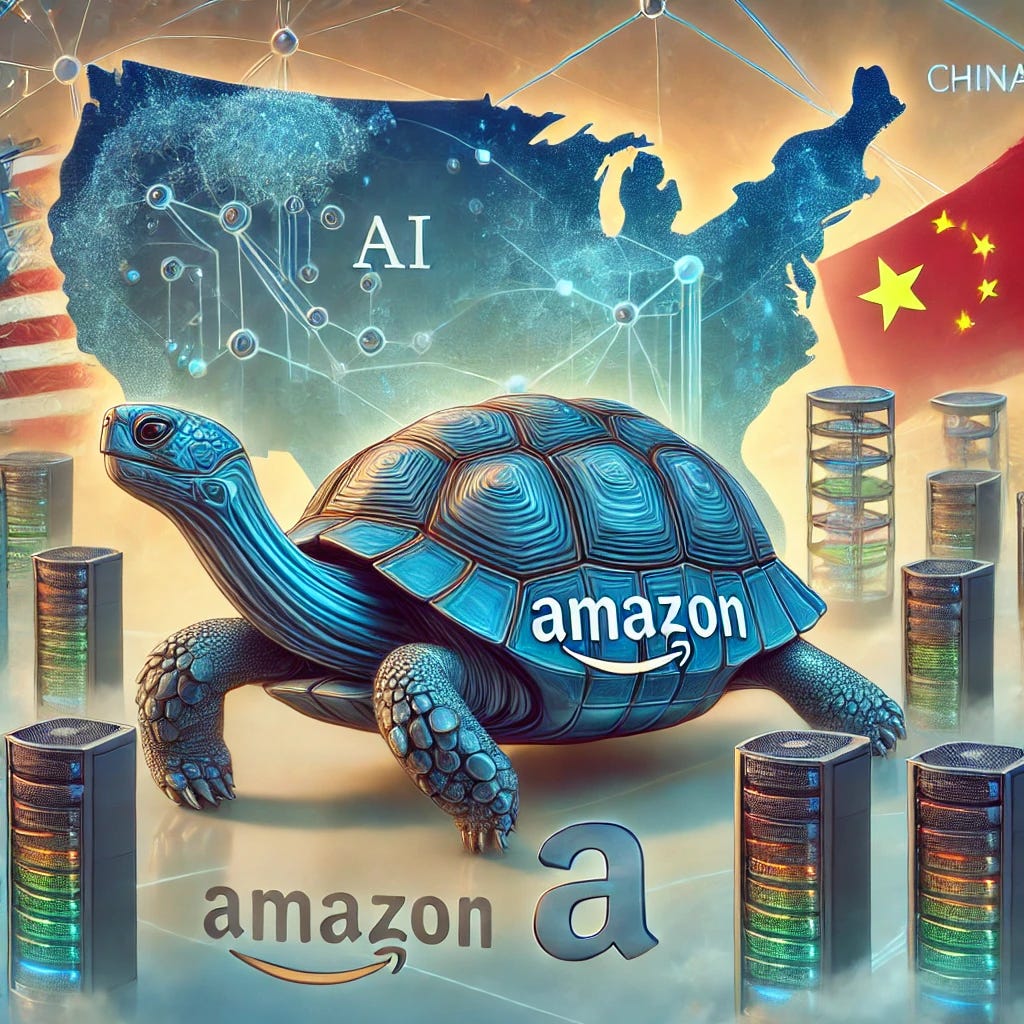In the frenzied AI arms race, dominated by flashy breakthroughs and headline-grabbing partnerships, Amazon has been the tortoise—slow and methodical. But as 2024 draws to a close, it’s clear this tortoise is poised not only to catch up but potentially to win, reshaping the AI landscape in the process. Let’s explore how Amazon’s steady ascent in AI mirrors its historical playbook, why its approach undercuts competitors, and how geopolitical shifts are positioning it as a key player in the AI cold war.
The AI Strategy: Slow but Calculated
For years, Amazon’s AI efforts seemed overshadowed by rivals like Microsoft, Google, and OpenAI. Yet 2024 marked a turning point. Amazon Web Services (AWS), the crown jewel of the company, unveiled a suite of innovations that signal its serious intent to dominate AI:
Proprietary Hardware: Amazon’s Trainium and Inferentia chips are game-changers. By reducing reliance on NVIDIA’s GPUs, these chips offer significant cost and performance advantages for AI training and inference. AWS has already positioned these tools as cheaper and faster alternatives, attracting major clients like Apple.
Generative AI Models: The Nova family of generative AI models, accessible through AWS Bedrock, enables enterprises to build custom AI applications with ease. Unlike competitors who gatekeep their models, Amazon focuses on adaptability, ensuring its tools are accessible to a broad spectrum of businesses.
Government and Military Contracts: AWS continues to secure high-profile government deals, leveraging its GovCloud infrastructure and security credentials. These relationships are key to its foothold in AI for defense and intelligence.
Strategic Partnerships: Amazon’s $4 billion investment in Anthropic underscores its commitment to generative AI while ensuring AWS remains Anthropic’s preferred cloud provider. Anthropic, favored by nerds and Silicon Valley insiders, brings cutting-edge research and credibility to Amazon’s portfolio while bolstering its customer base.
Undercutting the Market: A Classic Amazon Move
Amazon’s AI playbook follows a familiar pattern of disruption:
Economies of Scale: AWS operates on a scale few can match. By integrating proprietary hardware and optimizing infrastructure, Amazon undercuts competitors on cost while maintaining profitability. This strategy echoes how it conquered retail with lower prices and faster logistics.
Subsidization Across Verticals: Like Prime memberships subsidized retail dominance, AWS profits can absorb short-term losses in AI pricing wars. This cross-subsidization forces competitors, particularly smaller players, to either cut margins or bow out.
Platform Lock-In: By embedding AI capabilities within its broader AWS ecosystem, Amazon ensures clients depend on its tools, creating a sticky platform that’s hard to leave.
Dirty Tricks: Amazon’s history of using third-party seller data to compete with its own customers mirrors potential risks in AI. With a treasure trove of data flowing through AWS, Amazon is uniquely positioned to refine its tools while competitors tread carefully due to ethical and legal concerns.
Antitrust: The Vanishing Threat?
For years, Amazon loomed large in antitrust discussions. Lina Khan, the FTC’s current chair, built her reputation criticizing Amazon’s monopolistic tendencies. Yet, with Trump’s surprising return to power, the antitrust narrative may shift dramatically.
Trump’s administration has historically emphasized deregulation and business growth, potentially cooling antitrust enforcement. Furthermore, Bezos’ strategic suppression of a pro-Harris political endorsement in the The Washington Post and post-election overtures to Trump suggest a recalibration. Especially given Trump’s dislike of Meta and Google.
This shift may grant Amazon breathing room, allowing it to consolidate AI dominance without the regulatory roadblocks it faced under the Biden administration.
The AI Cold War: Amazon as a Strategic Asset
The ongoing AI cold war between the U.S. and China provides Amazon with a unique opportunity. The U.S. government has shown a willingness to invest in and partner with domestic tech giants to maintain global AI leadership. AWS, with its robust infrastructure and secure platforms, is an ideal partner for scaling AI projects critical to national security.
Export Control Policies: As the U.S. tightens restrictions on AI exports to China, Amazon’s domestic infrastructure becomes even more valuable.
Defense Applications: AWS’s collaborations with the Department of Defense position it as a central player in AI-driven military advancements, from logistics optimization to predictive analytics.
While predicting the future is a risky endeavor, Amazon’s trajectory in AI appears steady and unstoppable. Its tortoise-like strategy of methodical investment, cost leadership, and platform integration is a proven formula for success. If history is any guide, we should be wary. The AI industry’s flashiest players may dominate headlines, but Amazon’s slow and steady approach is set to dominate the market.
As the world becomes increasingly reliant on AI, the company’s influence will expand, raising critical questions about concentration of power, ethical AI development, and the role of government in regulating tech giants. For now, however, the tortoise is on the march—and it’s winning.





Very interesting article about AWS and its quiet, eminence grise climb in the AI landscape. Especially the description of its similarity to the way that Amazon cornered the market in ecommerce. Amazon is the recognized authority in western online retailing. Definitely a tortoise and a tricky one.